Suriya Gunasekar
Microsoft Research
Phi-4-reasoning Technical Report
Apr 30, 2025Abstract:We introduce Phi-4-reasoning, a 14-billion parameter reasoning model that achieves strong performance on complex reasoning tasks. Trained via supervised fine-tuning of Phi-4 on carefully curated set of "teachable" prompts-selected for the right level of complexity and diversity-and reasoning demonstrations generated using o3-mini, Phi-4-reasoning generates detailed reasoning chains that effectively leverage inference-time compute. We further develop Phi-4-reasoning-plus, a variant enhanced through a short phase of outcome-based reinforcement learning that offers higher performance by generating longer reasoning traces. Across a wide range of reasoning tasks, both models outperform significantly larger open-weight models such as DeepSeek-R1-Distill-Llama-70B model and approach the performance levels of full DeepSeek-R1 model. Our comprehensive evaluations span benchmarks in math and scientific reasoning, coding, algorithmic problem solving, planning, and spatial understanding. Interestingly, we observe a non-trivial transfer of improvements to general-purpose benchmarks as well. In this report, we provide insights into our training data, our training methodologies, and our evaluations. We show that the benefit of careful data curation for supervised fine-tuning (SFT) extends to reasoning language models, and can be further amplified by reinforcement learning (RL). Finally, our evaluation points to opportunities for improving how we assess the performance and robustness of reasoning models.
Phi-4 Technical Report
Dec 12, 2024Abstract:We present phi-4, a 14-billion parameter language model developed with a training recipe that is centrally focused on data quality. Unlike most language models, where pre-training is based primarily on organic data sources such as web content or code, phi-4 strategically incorporates synthetic data throughout the training process. While previous models in the Phi family largely distill the capabilities of a teacher model (specifically GPT-4), phi-4 substantially surpasses its teacher model on STEM-focused QA capabilities, giving evidence that our data-generation and post-training techniques go beyond distillation. Despite minimal changes to the phi-3 architecture, phi-4 achieves strong performance relative to its size -- especially on reasoning-focused benchmarks -- due to improved data, training curriculum, and innovations in the post-training scheme.
Phi-3 Technical Report: A Highly Capable Language Model Locally on Your Phone
Apr 23, 2024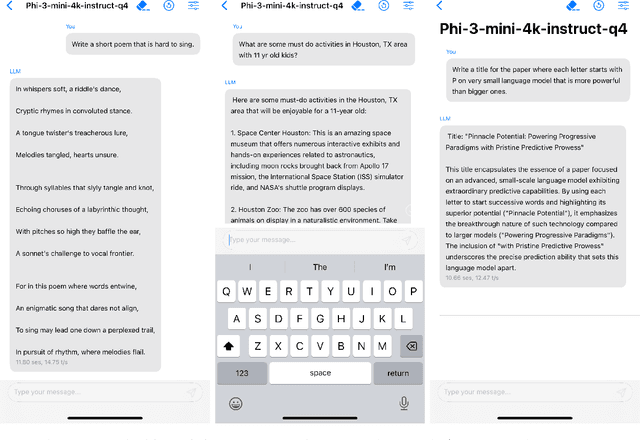

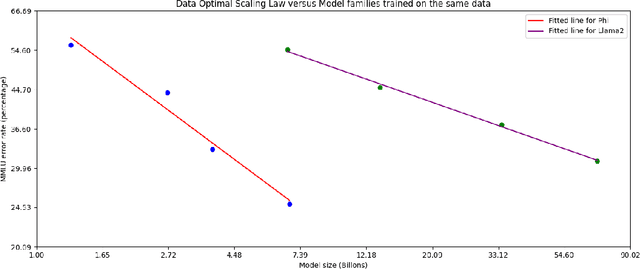
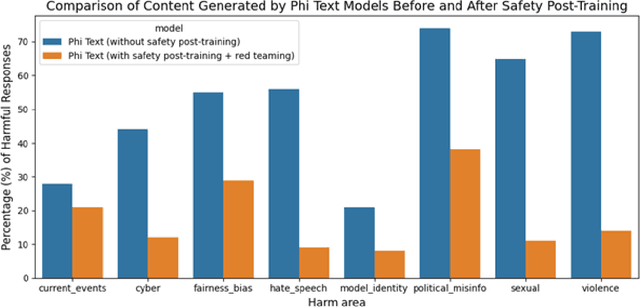
Abstract:We introduce phi-3-mini, a 3.8 billion parameter language model trained on 3.3 trillion tokens, whose overall performance, as measured by both academic benchmarks and internal testing, rivals that of models such as Mixtral 8x7B and GPT-3.5 (e.g., phi-3-mini achieves 69% on MMLU and 8.38 on MT-bench), despite being small enough to be deployed on a phone. The innovation lies entirely in our dataset for training, a scaled-up version of the one used for phi-2, composed of heavily filtered web data and synthetic data. The model is also further aligned for robustness, safety, and chat format. We also provide some initial parameter-scaling results with a 7B and 14B models trained for 4.8T tokens, called phi-3-small and phi-3-medium, both significantly more capable than phi-3-mini (e.g., respectively 75% and 78% on MMLU, and 8.7 and 8.9 on MT-bench).
KITAB: Evaluating LLMs on Constraint Satisfaction for Information Retrieval
Oct 24, 2023Abstract:We study the ability of state-of-the art models to answer constraint satisfaction queries for information retrieval (e.g., 'a list of ice cream shops in San Diego'). In the past, such queries were considered to be tasks that could only be solved via web-search or knowledge bases. More recently, large language models (LLMs) have demonstrated initial emergent abilities in this task. However, many current retrieval benchmarks are either saturated or do not measure constraint satisfaction. Motivated by rising concerns around factual incorrectness and hallucinations of LLMs, we present KITAB, a new dataset for measuring constraint satisfaction abilities of language models. KITAB consists of book-related data across more than 600 authors and 13,000 queries, and also offers an associated dynamic data collection and constraint verification approach for acquiring similar test data for other authors. Our extended experiments on GPT4 and GPT3.5 characterize and decouple common failure modes across dimensions such as information popularity, constraint types, and context availability. Results show that in the absence of context, models exhibit severe limitations as measured by irrelevant information, factual errors, and incompleteness, many of which exacerbate as information popularity decreases. While context availability mitigates irrelevant information, it is not helpful for satisfying constraints, identifying fundamental barriers to constraint satisfaction. We open source our contributions to foster further research on improving constraint satisfaction abilities of future models.
Attention Satisfies: A Constraint-Satisfaction Lens on Factual Errors of Language Models
Sep 26, 2023Abstract:We investigate the internal behavior of Transformer-based Large Language Models (LLMs) when they generate factually incorrect text. We propose modeling factual queries as Constraint Satisfaction Problems and use this framework to investigate how the model interacts internally with factual constraints. Specifically, we discover a strong positive relation between the model's attention to constraint tokens and the factual accuracy of its responses. In our curated suite of 11 datasets with over 40,000 prompts, we study the task of predicting factual errors with the Llama-2 family across all scales (7B, 13B, 70B). We propose SAT Probe, a method probing self-attention patterns, that can predict constraint satisfaction and factual errors, and allows early error identification. The approach and findings demonstrate how using the mechanistic understanding of factuality in LLMs can enhance reliability.
Textbooks Are All You Need II: phi-1.5 technical report
Sep 11, 2023

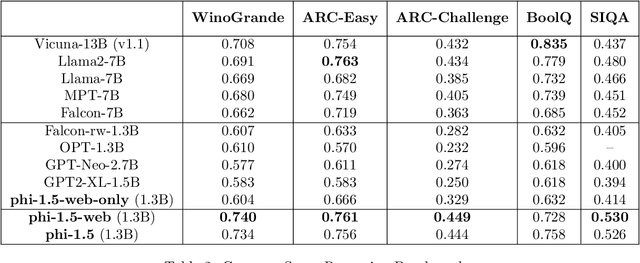
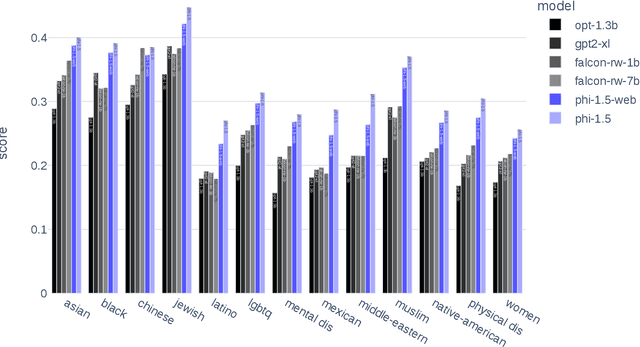
Abstract:We continue the investigation into the power of smaller Transformer-based language models as initiated by \textbf{TinyStories} -- a 10 million parameter model that can produce coherent English -- and the follow-up work on \textbf{phi-1}, a 1.3 billion parameter model with Python coding performance close to the state-of-the-art. The latter work proposed to use existing Large Language Models (LLMs) to generate ``textbook quality" data as a way to enhance the learning process compared to traditional web data. We follow the ``Textbooks Are All You Need" approach, focusing this time on common sense reasoning in natural language, and create a new 1.3 billion parameter model named \textbf{phi-1.5}, with performance on natural language tasks comparable to models 5x larger, and surpassing most non-frontier LLMs on more complex reasoning tasks such as grade-school mathematics and basic coding. More generally, \textbf{phi-1.5} exhibits many of the traits of much larger LLMs, both good -- such as the ability to ``think step by step" or perform some rudimentary in-context learning -- and bad, including hallucinations and the potential for toxic and biased generations -- encouragingly though, we are seeing improvement on that front thanks to the absence of web data. We open-source \textbf{phi-1.5} to promote further research on these urgent topics.
Textbooks Are All You Need
Jun 20, 2023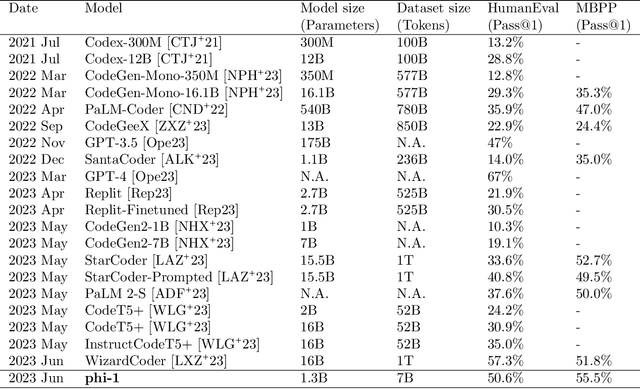

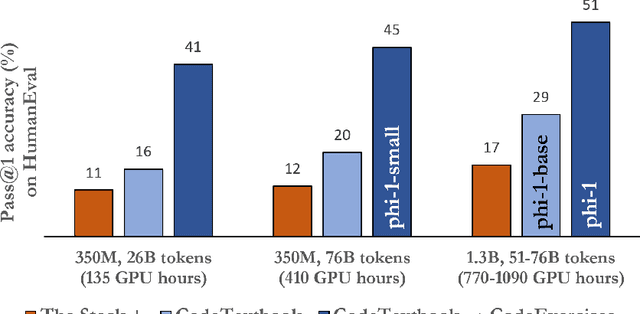
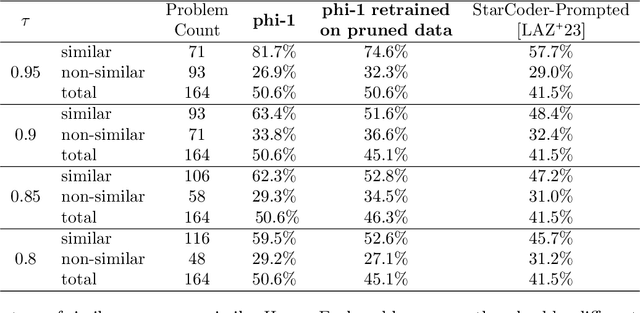
Abstract:We introduce phi-1, a new large language model for code, with significantly smaller size than competing models: phi-1 is a Transformer-based model with 1.3B parameters, trained for 4 days on 8 A100s, using a selection of ``textbook quality" data from the web (6B tokens) and synthetically generated textbooks and exercises with GPT-3.5 (1B tokens). Despite this small scale, phi-1 attains pass@1 accuracy 50.6% on HumanEval and 55.5% on MBPP. It also displays surprising emergent properties compared to phi-1-base, our model before our finetuning stage on a dataset of coding exercises, and phi-1-small, a smaller model with 350M parameters trained with the same pipeline as phi-1 that still achieves 45% on HumanEval.
(S)GD over Diagonal Linear Networks: Implicit Regularisation, Large Stepsizes and Edge of Stability
Feb 17, 2023Abstract:In this paper, we investigate the impact of stochasticity and large stepsizes on the implicit regularisation of gradient descent (GD) and stochastic gradient descent (SGD) over diagonal linear networks. We prove the convergence of GD and SGD with macroscopic stepsizes in an overparametrised regression setting and characterise their solutions through an implicit regularisation problem. Our crisp characterisation leads to qualitative insights about the impact of stochasticity and stepsizes on the recovered solution. Specifically, we show that large stepsizes consistently benefit SGD for sparse regression problems, while they can hinder the recovery of sparse solutions for GD. These effects are magnified for stepsizes in a tight window just below the divergence threshold, in the ``edge of stability'' regime. Our findings are supported by experimental results.
How to Fine-Tune Vision Models with SGD
Nov 17, 2022Abstract:SGD (with momentum) and AdamW are the two most used optimizers for fine-tuning large neural networks in computer vision. When the two methods perform the same, SGD is preferable because it uses less memory (12 bytes/parameter) than AdamW (16 bytes/parameter). However, on a suite of downstream tasks, especially those with distribution shifts, we show that fine-tuning with AdamW performs substantially better than SGD on modern Vision Transformer and ConvNeXt models. We find that large gaps in performance between SGD and AdamW occur when the fine-tuning gradients in the first "embedding" layer are much larger than in the rest of the model. Our analysis suggests an easy fix that works consistently across datasets and models: merely freezing the embedding layer (less than 1\% of the parameters) leads to SGD performing competitively with AdamW while using less memory. Our insights result in state-of-the-art accuracies on five popular distribution shift benchmarks: WILDS-FMoW, WILDS-Camelyon, Living-17, Waterbirds, and DomainNet.
Neural-Sim: Learning to Generate Training Data with NeRF
Jul 22, 2022



Abstract:Training computer vision models usually requires collecting and labeling vast amounts of imagery under a diverse set of scene configurations and properties. This process is incredibly time-consuming, and it is challenging to ensure that the captured data distribution maps well to the target domain of an application scenario. Recently, synthetic data has emerged as a way to address both of these issues. However, existing approaches either require human experts to manually tune each scene property or use automatic methods that provide little to no control; this requires rendering large amounts of random data variations, which is slow and is often suboptimal for the target domain. We present the first fully differentiable synthetic data pipeline that uses Neural Radiance Fields (NeRFs) in a closed-loop with a target application's loss function. Our approach generates data on-demand, with no human labor, to maximize accuracy for a target task. We illustrate the effectiveness of our method on synthetic and real-world object detection tasks. We also introduce a new "YCB-in-the-Wild" dataset and benchmark that provides a test scenario for object detection with varied poses in real-world environments.
 Add to Chrome
Add to Chrome Add to Firefox
Add to Firefox Add to Edge
Add to Edge